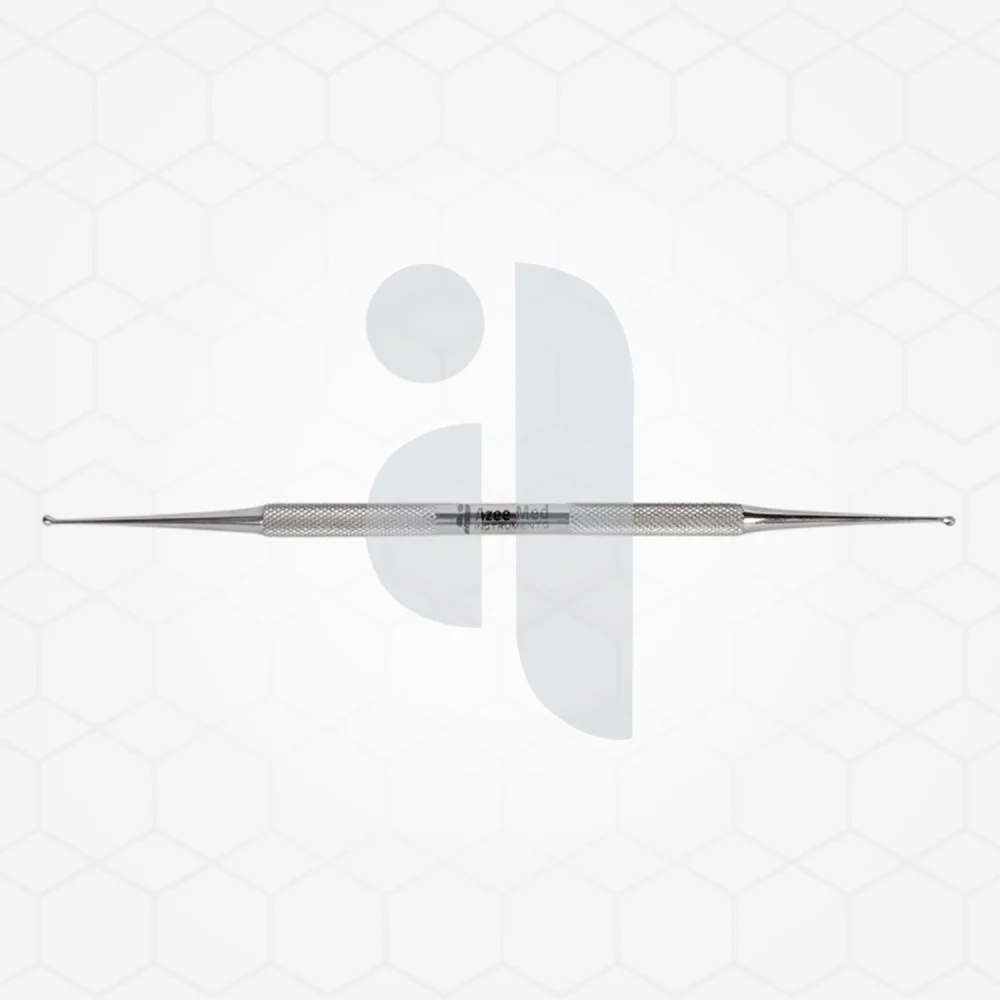The double-ended curette is a specialized surgical instrument widely used in various medical fields, including dentistry, orthopedics, gynecology, and ear, nose, and throat (ENT) surgery. Known for its unique design and versatile functionality, this tool is primarily used for scraping, debridement, and removing tissue or debris from body cavities or surfaces. The double-ended curette makes the curette highly efficient and adaptable, providing surgeons with the flexibility to perform intricate procedures with greater precision.

Design and Structure of the Double-Ended Curette
The double-ended curette features two distinct working ends, each designed for specific tasks. These ends are typically shaped like scoops or loops, with one end being larger or more curved than the other. The dual ends allow surgeons to choose the most appropriate side based on the surgical needs and the area being treated. The handle is usually made of durable stainless steel, ensuring strength and resistance to corrosion, which is vital in maintaining the tool's functionality over time.
The curette's design provides surgeons with flexibility and control, as it can be used for delicate tasks requiring a light touch, as well as for more forceful scraping or debridement. Depending on the surgical procedure, the curette's ends may vary in shape and size, allowing the instrument to be customized for different applications. The double-ended feature helps improve surgical efficiency by eliminating the need for multiple tools, as one instrument can serve various functions during the same procedure.
Applications of the Double-Ended Curette
The double-ended curette is employed across various medical disciplines, each with specific uses based on the nature of the surgery. In dentistry, this instrument is commonly used for root planing, scaling, and periodontal treatments. The scoop-shaped ends allow dental professionals to carefully scrape away tartar, plaque, and infected tissue from the gums and teeth, ensuring a clean and healthy oral environment. Its ability to remove debris and diseased tissue makes it an essential tool in preventing the progression of gum disease.
In gynecology, the double-ended curette is often used in procedures such as dilation and curettage (D&C). This procedure involves scraping the lining of the uterus, and the curette’s ability to remove tissue effectively without causing damage to surrounding areas is crucial. The double-ended design ensures that the procedure is completed efficiently, with the surgeon being able to switch ends depending on the area of the uterus being treated.
Orthopedic surgeons may also use double-ended curettes for cleaning bone surfaces during surgery. Whether removing tissue or preparing bone sites for grafting or implant placement, the curette’s precision is invaluable in delicate orthopedic procedures. Its dual ends offer flexibility for different bone shapes and sizes, making it an adaptable instrument for surgeons working in tight spaces.
In ENT surgery, the double-ended curette is used for procedures like sinus surgeries or the removal of debris from the ear canal. The ability to scrape delicate tissues or clear sinus cavities without causing excessive trauma is crucial in these sensitive areas. The dual design allows ENT surgeons to quickly switch between the ends for precise tissue removal, improving efficiency and reducing patient recovery time.
Advantages of Using a Double-Ended Curette
The double-ended curette offers several distinct advantages in surgical settings. One of the main benefits is its versatility. With two different working ends, the curette can be used for a wide range of tasks, including scraping, debridement, and tissue removal. Surgeons can adapt the tool to different sizes and shapes of surgical sites, improving precision and efficiency during procedures.
Another advantage is the curette’s ergonomic design, which provides the surgeon with excellent control over the instrument. The handle's durability ensures it withstands the mechanical stress of surgery, while the dual-ended structure minimizes the need for switching between multiple tools. This streamlines the surgical process, allowing surgeons to focus on the procedure itself rather than worrying about changing instruments.
Additionally, the double-ended curette's ability to handle both delicate and forceful tasks makes it suitable for a variety of surgical fields. Its precision allows surgeons to work in tight or sensitive areas, while its design enables efficient tissue removal. This makes it a versatile and essential tool for many types of surgery.
Maintenance and Care of the Double-Ended Curette
Proper maintenance and care are crucial to ensure that the double-ended curette remains effective and functional over time. Like all surgical instruments, the curette should be thoroughly cleaned and sterilized after each use to prevent the buildup of bacteria or other contaminants. Cleaning the curette also helps preserve its sharpness and functionality, ensuring that it remains ready for use in future surgeries.
Inspecting the curette regularly is essential to ensure that both ends are intact and sharp. If the scoop-shaped ends become dull or damaged, the curette should be replaced or repaired to prevent complications during surgery. The handle should also be checked for any signs of wear, as a damaged handle can compromise the instrument’s effectiveness and safety.
The curette should be stored in a clean, dry place, and its ends should be protected from any potential damage. Using instrument trays or covers can help prevent the curette from coming into contact with other tools or surfaces that could cause damage.
Conclusion
The double-ended curette is an indispensable tool in the world of surgery, offering versatility, precision, and efficiency for a range of medical applications. Its dual ends provide flexibility for various tasks, from scraping and debridement to tissue removal, making it suitable for use in dentistry, gynecology, orthopedics, and ENT surgery. The design of the double-ended curette allows for excellent control and adaptability, streamlining the surgical process and improving outcomes. By adhering to proper maintenance and care guidelines, healthcare professionals can ensure that this critical tool remains in top condition, providing reliable performance throughout numerous procedures.
Comments on “Double-Ended Curette: A Crucial Tool in Surgical Procedures”